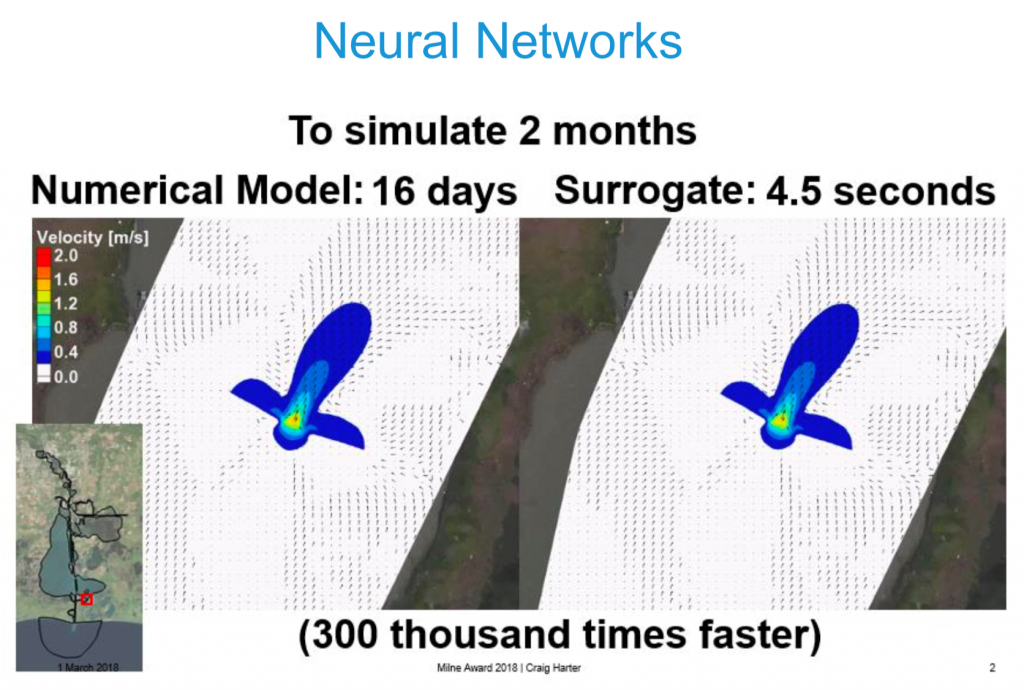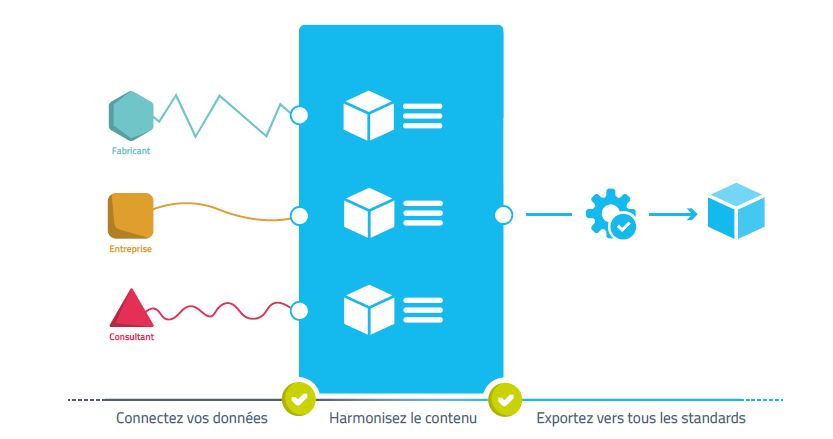The preliminary stages towards success!
The use of BIM and digital technology is today enabling businesses to automate a number of tasks, with reduction in errors, the elimination of non-value added repetitive tasks and improved control over the quality of deliverables central to this process.
Genuine and bona fide tools such as deep learning and artificial intelligence are now becoming available to BIM teams as well as both design and construction companies.
How can you get involved in this promising phase of construction industry digitalisation?
Automation: refocussing yourself on your trade or profession
A building or piece of infrastructure is a complex construction requiring the involvement of hundreds of different trades and professions across its entire life cycle. Companies today want to avoid tackling each new project as if it were their first, i.e. in the same way they’d approach a prototype building; they want instead to successfully industrialise their procedures and capitalise on their knowledge so they can improve the way they design and construct and make maintenance easier.
The purpose of automation is to use the power of information technology to automate repetitive or error-prone tasks and liberate teams from the need to carry out tasks providing low levels of added value, thus freeing them up to concentrate on the essentials: constructing to a higher standard, building sustainably and staying competitive in a fast-evolving marketplace.
The world of construction is effectively undergoing a phase of exponential acceleration and automation, and this same phenomenon also applies to our own industry, as Peter Diamondis of Singularity University explains.
As we shall see, in the world of building construction automation can serve different purposes, depending on whether it’s implemented by a developer or a design office.
Automating the process of updating information in the various different tools used by the company
It is still difficult today to synchronise the various different applications used in the building industry, and this is despite the promising potential BIM offers for collaborative working. The following are a few examples of requirements and expectations in terms of synchronisation:
– Progress monitoring for the site steel reinforcement checking process reported directly in the model,
– Transferral of the model to the as-built file, or synchronisation with it, with the as-built file itself accessible to the CMMS system,
– Maintenance check reports accessible to the building manager,
– Structural data accessible to the architect, etc.
These synchronisation processes make it possible to “de-insularise” the data and reach quicker and more accurate decisions by working collaboratively with the information in question, thus achieving gains in productivity.
Automating profession/trade specific calculations or documentation processes.
Let’s take at look at the example of the automation of prefabricated concrete production: Groupe GA manages to deliver concrete constructions on a just-in-time basis by having its concrete factories connected to its design office. The group’s processes turn the building and the concrete components into reality directly from the digital model.

Groupe GA’s synchronisation process: Design -> Production (automatic) then Assembly
Finding solutions to complex problems
Mott MacDonald’s international design office decided to place its faith in new technologies such as deep learning when it came to automating the structural calculations at the design phase, and for the purpose of evaluating natural risks for coastal protection projects.

Source : Mott MacDonald
Design and construction companies such as Mott MacDonald develop their own software themselves. Their aim in doing this is to provide the various specialised professional teams with very simple workflows, thus making life easier for them (incidentally, many professional specialists are saying they don’t even want to see Revit any more).
The model is becoming an interface that provides access to the information and can be used like a database that needs to be updated and queried, using, in particular, Grasshopper, Dynamo and the Forge and Onfly.io APIs from BIM&CO.
Nevertheless, the process of automation still remains complicated today. With digital technology, it’s possible to end up spending more time managing software problems than actually drawing real benefit from it by using it to deal with a real and tangible operational problem.

Why is this the case?
There are several reasons. To automate the tasks, the BIM and IT teams try to get the information to transit between the various software packages or teams. However, this is not always easy to do as these software components do not speak the same language. Imagine trying to get teams of Japanese and Americans to work together without the help of a translator – not easy if you don’t happen to be bilingual. And this translation problem is exacerbated in the case of complex projects.
The models themselves have numerous data items stored within them, making them difficult for external applications to access. This means the data remains unaccessed and therefore unexploited.
Additionally, the tools used vary from project to project or from client to client, and the types of information also differ due to the fact that the data exchange processes have not yet been standardised.
Managing this data, an essential step in the automation process: from project to BIM object
What does “managing this data” mean? Everything and nothing!
Today, an enormous amount of information is provided inside the digital models themselves, e.g. software-specific data, documents, etc. In order to exploit this information and be able to really make use it, it will need to be managed, i.e. we have to be capable of identifying it, modifying it and reading it.
Structure and standardise your data
The basic principle underpinning everything is that of enabling the information supplied in the model to be understood via a computer. This means establishing a common language and ensuring that this data can be read and interpreted by different applications and for different distinct teams.
In specific, concrete terms, the first stage consists of identifying and defining the information required by the processes, which is dependent on the stage the project is at and the particular project participants involved, etc.
This information then needs to be standardised. The teams therefore put in place naming rules to ensure uniformity within the model. We often find the details of the project data conventions and naming rules, the object parameters, and the classifications to use contained in BIM execution plans.

Extract from a BIM execution plan
The term “property naming” applies to the object parameters, and we use the term “classification” for the naming conventions used within the object itself. These classifications are codifications that differ from one trade/profession to another and vary dependent on the software used to access the model.
One way of ensuring the uniqueness of these properties is to base the system on a dictionary of common properties. Such a dictionary will make it possible to have properties that are uniform and… interpretable. This is effectively the final stage: the ability to translate the data to different standards, into different languages, etc. has now been acquired. This is the crucial element enabling the various applications to exchange data.
Harmonise your data and your existing content
Once these rules have been defined, all that then remains to do is make the BIM objects used in the projects comply with the rules, or to express it in commonly used terms: harmonise the objects and their data.
The objects, once harmonised, become the construction tools used to build a rich, detailed and usable BIM model.

Checking and sharing the information contained in the models
Caution: you’ll now need to apply these rules and ensure they’re complied with – not an easy task. With numerous project participants collaborating together on one or multiple models, you will need to ensure that the data rules and structures are complied with in order for the trade/profession specific model to be integrated into the central model. There are tools available that you can use to ensure compliance with the rules defined in the BIM execution plan.
Proper management of BIM data, and especially BIM object data, enables greater process efficiency, improved checks and controls, and greater data accessibility.
With the data managed correctly and on a continuous, ongoing basis, you can then not only apply machine learning and predictive maintenance, but you can also automate standards checking processes or even produce much more accurate costs estimations.
Using APIs and OpenBIM to integrate the processes with the company’s own systems
Process automation can be carried out either internally using a tool designed for the purpose or externally using APIs. With data exchange processes themselves also not standardised, the same set of project data standards can be used to more easily distribute the information.
The use of a set of data standards essentially enables you to ensure the continuity of use of a common language across multiple applications. This then allows you to put in place API-based automatic processes around the model.
IT integration solutions often have to be implemented within the company or within the project stakeholder organisations: the technical data can come directly from a supplier’s PIM system, the delivery lead times directly from the purchasing software (for example), and the maintenance data can be pushed to an asset management solution, such as.Maximo… This makes it possible to optimise the entire maintenance and supply chain.
The use of IFC
When it comes to exchanging and automating processes involving the model, IFC offers a very good way of aiding and supporting collaborative working. When used in conjunction with external cloud-based tools, IFC constitutes an essential framework for collaborative working and process automation (in Europe at least).
By following and carrying out these stages, it is possible to easily access the benefits of automation, i.e. easy connection of the project data to the company’s information systems, such as ERPs, and improved collaborative working by breaking the data silos. Ultimately, this is what BIM is all about.
